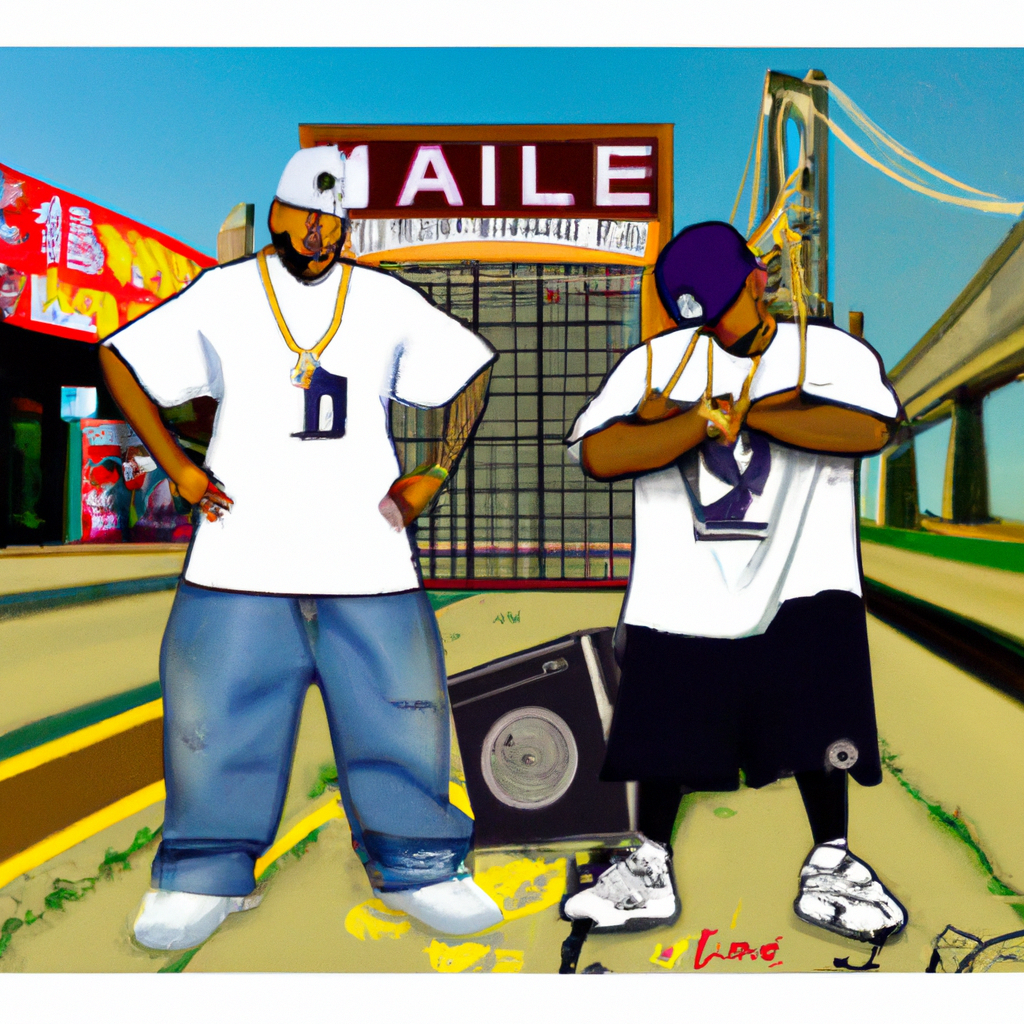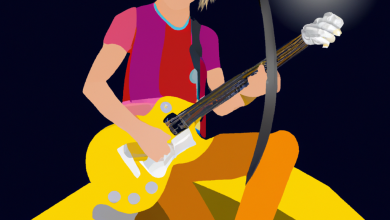
I. Introduction
Hip-hop is a genre of music that originated in the South Bronx of New York City, in the 1970s. It has since become the most popular genre of music in the United States. With its unique style, hip-hop has become a means of self-expression for young people, especially in urban areas, and has gone on to become an influential cultural force worldwide.
The roots of hip-hop can be traced back to DJ Kool Herc, who is credited with inventing the breakbeat, a technique used by DJs to mix two copies of the same record to create a longer beat for dancing. MCing, or rapping, was then added by artists like Grandmaster Flash and the Furious Five, who used rhyming and spoken word to create lyrics over the beat. Hip-hop also included elements like breakdancing, graffiti, and fashion – all of which contributed to the culture and aesthetic of the genre.
Hip-hop’s origins in impoverished and predominantly Black and Latinx communities meant that it had a more underground and grassroots beginning. However, the genre’s growing appeal to young people, who were drawn to its urban, rebellious identity and fresh sound, saw it rise in popularity throughout the 1980s and 1990s. As hip-hop was embraced by mainstream media and record labels, its reach expanded and so too did its influence.
One factor that contributed to hip-hop’s rise was its ability to speak to its listeners in a way that resonated with them. Hip-hop lyrics often deal with the realities of life in urban communities, from police brutality to poverty to gang violence, and offer a voice to those who might otherwise be marginalized. Additionally, hip-hop has always been a genre that has embraced variety and innovation, which has allowed it to evolve with the times and make new fans.
The digital age has also played a significant role in hip-hop’s continued rise to dominance. Streaming services and social media platforms have made it easier for fans to access and share music, and for artists to create and distribute music on their own terms. This has given rise to a new era of DIY hip-hop, in which independent artists can create and release music without the support of traditional record labels and still reach a global audience.
In conclusion, hip-hop’s journey from an underground movement to the most popular genre is the result of a combination of factors. From its cultural impact to its evolving artistry, hip-hop continues to push boundaries and expand its reach. The genre’s unique ability to speak to its listeners and offer a voice to the marginalized has made it an important cultural force in American music and beyond.

II. Cultural Influence
Hip-hop is more than just a music genre. It is a cultural phenomenon that has had a significant impact on society, including language, fashion, and community. The cultural influence of hip-hop is one of the primary reasons that it has become the dominant genre in American music.
One of the most noticeable ways that hip-hop has influenced society is through language. Whether it’s slang, metaphors, or wordplay, hip-hop has introduced new words and phrases that have become part of mainstream language. Hip-hop artists have coined words such as “bling,” “dope,” and “janky.” The usage of these words in popular culture demonstrates the language’s impact in hip-hop. The use of these words has expanded beyond the genre and has become part of everyday conversation.
Hip-hop fashion is another cultural influence that has become part of mainstream culture. Baggy pants, oversized t-shirts or hoodies, and sneakers have become fashion staples in hip-hop culture over the years. Hip-hop fashion has been embraced by music fans who love the culture, making it a fashion trend that has spanned generations. Many clothing brands have collaborated with hip-hop artists for merchandise or signature clothing lines that have since become popular. Even some high-end fashion brands have adopted hip-hop’s signature style and integrated it into their collections.
One of the most significant cultural impacts of hip-hop is the sense of community it has created. Hip-hop has become a platform for artists to share their experiences and create inclusive communities through their music and live performances. Hip-hop creates opportunities for fans to come together and celebrate a shared love for the culture. The culture of hip-hop helps to empower young people, providing them with a sense of belonging to something positive.
In conclusion, hip-hop’s cultural influence on language, fashion, and community plays a crucial role in its popularity. The culture’s impact has not only earned hip-hop a place in mainstream culture but also a critical role in shaping contemporary American culture. As hip-hop continues to evolve and innovate, it will continue to shape and influence society in new and exciting ways.
III. Mainstream Acceptance
Hip-hop’s popularity and cultural influence today is undeniable, but it wasn’t always that way. In its early days, it was a primarily underground genre that was often stigmatized by the mainstream media. However, over time, hip-hop managed to make its way into the mainstream and become the dominant genre in American music.
One of the key factors that contributed to hip-hop’s mainstream acceptance was the role played by record labels and the music industry. As hip-hop became more popular, record labels began to take notice of the genre’s potential for commercial success. They started to sign and promote hip-hop artists, which helped bring hip-hop to a wider audience.
At the same time, the media played a significant role in spreading hip-hop to the masses. The rise of music videos, MTV, and other networks helped to popularize hip-hop among younger viewers. Hip-hop artists like Run-DMC were able to break through to mainstream audiences with their music videos, which featured urban fashion styles like Adidas sneakers and tracksuits.
One of the most significant moments in hip-hop’s mainstream acceptance came in 1988, when DJ Jazzy Jeff & The Fresh Prince (now known as Will Smith) won the first-ever Grammy Award for Best Rap Performance for their hit song “Parents Just Don’t Understand.” This achievement was notable, as it demonstrated that hip-hop was starting to be taken seriously by the music industry’s mainstream establishment.
Hip-hop’s popularity continued to grow throughout the 90s and 2000s, with artists like Tupac, The Notorious B.I.G., Jay-Z, and Eminem achieving massive commercial success. At its peak, hip-hop was the most commercially successful and widely consumed genre of music in the United States.
Today, hip-hop’s mainstream acceptance is evident in the way it permeates pop culture. Hip-hop music, fashion, and language can be seen and heard in movies, television shows, and advertisements, and hip-hop stars are among the most recognizable and influential celebrities in the world.
Overall, mainstream acceptance played a pivotal role in hip-hop’s rise to dominance. Without the support of record labels and media outlets, it’s unlikely that hip-hop would have been able to reach the heights it has achieved today.
IV. Digital Age
The digital age has played a significant role in the growth of hip-hop as a dominant genre in American music. The rise of digital technology and social media has opened new opportunities for hip-hop artists to connect with their audiences and gain exposure. In the past, music distribution was limited to physical records, tapes, and CDs. Hip-hop artists struggled to gain airplay on mainstream radio stations, and record labels controlled access to the music industry.
With the advent of digital technology, hip-hop artists can distribute their music through online platforms and social media. Artists can reach their audiences globally without the need for a middleman. Social media has made it easier for hip-hop artists to promote their music and connect with their fan base. Platforms like Twitter, Instagram, and YouTube have enabled artists to showcase their music videos, share snippets of new music, and interact with their followers directly.
The music industry has also adapted to the digital age in relation to hip-hop. Record labels and music distributors have developed new models for releasing and distributing music. Streaming services have become the dominant method of music consumption, and hip-hop has emerged as the most-streamed genre. This has changed the way the music industry works, as streaming platforms now play a significant role in promoting and discovering new artists.
Hip-hop has also been at the forefront of technological innovation in the music industry. Producers and artists have embraced digital tools to create their music, and the genre has played a significant role in developing new technologies for music production. Some of the most popular music production tools like MIDI controllers and drum machines were pioneered by influential hip-hop producers.
In conclusion, the digital age has played a significant role in the growth and success of hip-hop as America’s dominant genre. The rise of digital technology and social media has opened new opportunities for artists to connect with their audiences and promote their music. The music industry has also adapted to the digital age, as streaming services and online platforms have become the dominant method of music consumption. Hip-hop has played a significant role in shaping these trends, and the genre is likely to continue driving innovation in the music industry.
V. Artistic Evolution
Hip-hop has undergone an incredible artistic evolution over the years since its inception in the late 1970s. Early hip-hop was characterized by its heavy use of sampling, turntables, and recontextualization of older music. Early pioneers of the genre such as Grandmaster Flash, Afrika Bambaataa, and DJ Kool Herc were masters of turntablism, scratching, and mixing, creating sounds that were completely new and revolutionary at the time. The lyrics of early hip-hop often dealt with social and political issues, depicting life in the inner-city and shining a light on the struggles and injustices faced by African-American communities.
As hip-hop grew in popularity and more artists began to experiment with different styles and techniques, the genre underwent a dramatic transformation. The 1980s and 90s saw the emergence of new subgenres such as gangsta rap, which featured a much more aggressive and violent style of lyricism. In contrast, alternative hip-hop embraced a more experimental and avant-garde approach in both its music and lyrics.
One of the most significant changes in the evolution of hip-hop was the introduction of the digital age. As the music industry shifted to digital formats and production became more digital-based, hip-hop artists began to incorporate electronic instruments and software into their music, leading to the development of new sounds and production techniques. This shift in production allowed for more experimentation and innovation in hip-hop than ever before.
In modern-day hip-hop, the genre has continued to evolve and expand, with new subgenres and regional scenes emerging all the time. For example, trap music, which originated in Atlanta in the 2000s, has now become one of the most popular subgenres of hip-hop, with artists like Future, Migos, and Lil Uzi Vert taking the sound to new heights. In addition, social media and streaming services have allowed for greater accessibility and exposure for up-and-coming hip-hop artists, leading to a democratization of the genre.
Overall, hip-hop’s evolution as an art form has been a constantly changing and evolving process. From its early beginnings as a subculture in the Bronx to its current position as the dominant genre in American music, hip-hop has always been at the forefront of musical innovation and creativity. With new artists and sounds emerging all the time, the future of hip-hop is sure to be just as exciting as its past.
VI. Criticisms and Controversies
Hip-hop has often been at the center of controversy since its emergence in the 1970s. Despite the genre’s popularity and huge influence on American culture, it has faced criticism and controversies over the years.
One major criticism of hip-hop has been its explicit language and lewd portrayals of women. Many people, including religious and conservative groups, have criticized the vulgar content in hip-hop, arguing that it degrades values and harms communities. In addition, some have accused hip-hop music of promoting violence and drug use, especially in its early days when gangsta rap was prevalent.
However, hip-hop has also been praised for its ability to shed light on social issues and give voice to marginalized groups. Hip-hop has been used as a tool for political activism and a platform for social commentary. For example, Public Enemy’s “Fight the Power” became an anthem for the civil rights movement in the late 1980s.
Hip-hop has responded to the criticisms and controversies in various ways, with some artists using their music to address social issues and others simply choosing to ignore the criticisms. Some hip-hop artists have also started to incorporate more positive and uplifting content into their music, especially in response to the criticisms of the genre’s negative impact on society.
Additionally, hip-hop has faced controversies regarding cultural appropriation. In recent years, there have been debates surrounding the use of hip-hop by non-black artists, with some labeling it as cultural theft. Many have criticized white artists who profit off the genre despite not having lived through the same experiences that black people have.
Despite the criticisms and controversies, hip-hop remains the most dominant genre in American music. Its ability to evolve and adapt has enabled it to remain relevant and influential in American culture.
VII. Conclusion
Hip-hop rose to prominence in the United States during the 1980s, and over the years, it has become the country’s most popular genre. The rise of hip-hop had significant influences that helped shape American music and culture.
Hip-hop’s impact on American society was far-reaching, having a significant cultural influence on language, fashion, and community. The genre provided a voice for marginalized individuals, giving them a platform to express themselves creatively, and helped break down barriers between different groups of people.
The mainstream’s acceptance of hip-hop helped propel it to its current position as the dominant musical genre in the U.S. The rise of the digital age and social media also allowed hip-hop to reach a broad audience and grow its influence globally.
Hip-hop also evolved substantially as an art form, with early hip-hop in the 1980s and early 1990s having a distinct sound and style compared to modern-day hip-hop. Hip-hop artists’ ability to innovate and merge various musical styles has helped keep the genre relevant and exciting.
However, hip-hop has also faced criticisms and controversies, particularly regarding its lyrics and imagery. Critics have challenged the genre’s portrayal of violence and misogyny, leading to debates about hip-hop’s place in mainstream culture. However, Hip-hop artists and community continue to push back against these criticisms and argue for greater representation and inclusivity.
In conclusion, hip-hop’s rise to dominance in American music was the result of a combination of cultural influence, mainstream acceptance, digital technology, artistic evolution and innovation, and controversies. Hip-hop has left an indelible mark on American culture and music, with its influence extending far beyond the genre itself. And despite criticism and controversy, hip-hop remains an essential part of American life, providing a voice for the voiceless and a platform for self-expression across racial and cultural boundaries.



